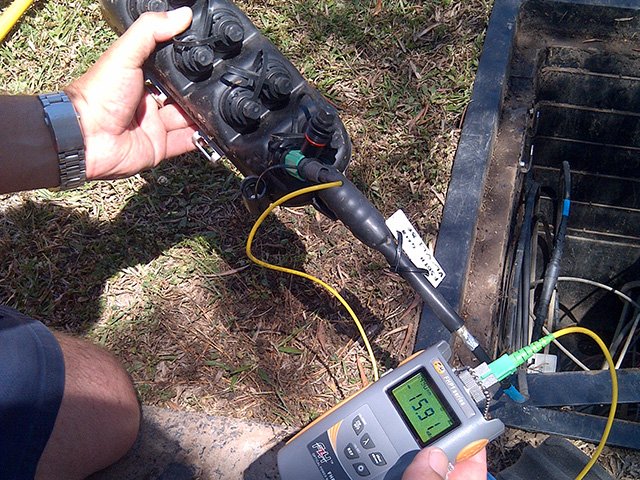The latest optical fibre testing equipment improves troubleshooting and diagnostics in telecommunications.
Discover the Importance of Optical Fibre Testing in Modern Telecom
In the world of modern telecommunications, the importance of optical fiber screening can not be overemphasized, as it works as the foundation for ensuring network dependability and performance. By executing normal screening procedures, operators can preemptively determine potential concerns such as signal destruction, therefore securing against disruptions that might prove pricey. Advanced techniques like Optical Time-Domain Reflectometry play a crucial role in this process, yet lots of might neglect the broader effects of these methods. What are the certain advantages that normal testing offers, and just how might it form the future landscape of telecommunications?

Recognizing Optical Fiber Testing
Optical fibre testing is a crucial procedure in telecommunications that makes certain the integrity and performance of fibre optic networks. This screening incorporates a series of treatments made to assess the physical and useful characteristics of optical fibres - fibre testing equipment. Trick criteria analyzed consist of optical power loss, data transfer capability, and mistake place, which are necessary for maintaining top notch interaction web links
The testing process usually entails using specialized devices such as Optical Time-Domain Reflectometers (OTDR) and Optical Power Meters. OTDRs are employed to identify and characterize faults, interlaces, and ports within the fibre, while power meters determine the transmitted light signal stamina to determine effectiveness.
Additionally, testing is performed at different stages, consisting of throughout setup, maintenance, and troubleshooting, to make certain that the network satisfies sector standards and functional requirements. Compliance with requirements established by organizations like the International Telecommunication Union (ITU) and the Telecoms Industry Association (TIA) is paramount.
Benefits of Routine Evaluating
Normal screening of optical fibres yields various advantages that considerably improve network integrity and performance. Among the key benefits is the very early detection of potential issues, such as breaks or degradation in the fibre, which can result in pricey downtime if left unaddressed (fibre testing equipment). By recognizing these problems proactively, telecommunications carriers can reduce solution interruptions and ensure regular connection for their clients
Additionally, normal screening helps to keep the integrity of signal high quality. As optical fibers age, their efficiency can be affected by aspects such as environmental conditions and physical anxiety. Routine evaluations enable the monitoring of signal loss and total transmission effectiveness, guaranteeing that the network runs at optimum levels.
Another substantial benefit is compliance with industry requirements. Routine testing supports adherence to governing needs, consequently minimizing legal and monetary threats connected with non-compliance. It boosts the general life expectancy of the fibre infrastructure by helping with prompt maintenance and repair work.

Common Evaluating Techniques
Examining optical fibres employs various techniques to make certain the honesty and performance of telecoms networks. Amongst the most common methods is Optical Time Domain Name Reflectometry (OTDR), which examines the whole length of the fiber by sending out a pulse of light and gauging the representations brought on by blemishes or breaks. This method supplies in-depth information about the place and severity of faults.
Another common approach is the use of Optical linked here Power Meters, which measure the amount of light transmitted through the fiber. This strategy aids establish the loss of signal toughness, making sure that it satisfies industry standards. Furthermore, Visual Mistake Locators (VFL) are utilized to recognize breaks or serious bends in the fibre by projecting a visible laser light right into the cable television.
Insertion loss screening is likewise crucial, as it evaluates the loss of signal power resulting from connections and mates within the network. In addition, the use of Polarization Mode Dispersion (PMD) screening evaluates the impact of fibre qualities on signal stability.
Each of these approaches plays a vital duty in maintaining the efficiency and reliability of optical fibre networks, ultimately contributing to seamless telecoms operations.
Impact on Network Performance
The honesty and performance of optical fiber networks directly affect overall network performance. In modern telecommunications, the effectiveness of information transmission depends greatly on the high quality of the optical fibres made use of. Any kind of degradation in the fiber's problem-- whether as a result of physical damages, contamination, or excessive flexing-- can bring about enhanced attenuation and signal browse around these guys loss, dramatically impacting information stability and speed.
Regular optical fiber testing is vital to determine and rectify possible problems before they manifest as network failures or stagnations. Strategies such as Optical Time Domain Name Reflectometry (OTDR) and insertion loss testing enable professionals to determine the performance of fibre links precisely. These examinations not just examine the physical problem of the fibres however also make certain conformity with industry criteria, thereby guarding the network's integrity.
Additionally, a properly maintained optical fiber network adds to reduced operational costs and improved consumer complete satisfaction, as end-users experience less disturbances and higher information rates. Eventually, the focus on strenuous optical fibre testing methods functions as a keystone for sustaining robust telecommunications facilities, making certain that company can fulfill the expanding needs for data transfer and connectivity in today's digital age.
Future Trends in Testing
As we look ahead, innovations in innovation are positioned to improve optical fibre screening in telecoms. The surge of automation and man-made intelligence (AI) is expected to boost the performance and precision of testing processes. Automated screening systems can carry out detailed analyses with very little human treatment, considerably lowering the capacity for errors and expediting time-to-deployment.
Additionally, the assimilation of artificial intelligence algorithms will make it possible for predictive upkeep, enabling network providers to predict potential issues before they escalate right into failures. This aggressive technique not only boosts network reliability yet additionally enhances operational prices.
Another arising pattern is the advancement of portable testing tools that provide real-time evaluation - fibre testing equipment. These tools will encourage technicians to perform on-site diagnostics swiftly, assisting in quicker resolutions and boosting service top quality
The growth of 5G networks even more requires the advancement of testing approaches. As bandwidth demands enhance, standard testing strategies might no longer are enough. Ingenious remedies such as optical time-domain reflectometry (OTDR) and progressed spooky evaluation will certainly become essential in making certain the honesty and efficiency of high-speed links.

Conclusion
To conclude, optical fiber testing is crucial for ensuring the integrity and dependability of modern telecommunications networks. Regular screening practices not just assist recognize potential concerns such as signal loss and faults yet also add to enhanced network performance and customer contentment. As the demand for seamless connection remains to grow, the fostering over here of sophisticated screening methods will certainly play a crucial role in maintaining top quality network criteria and supporting the developing landscape of telecommunications.